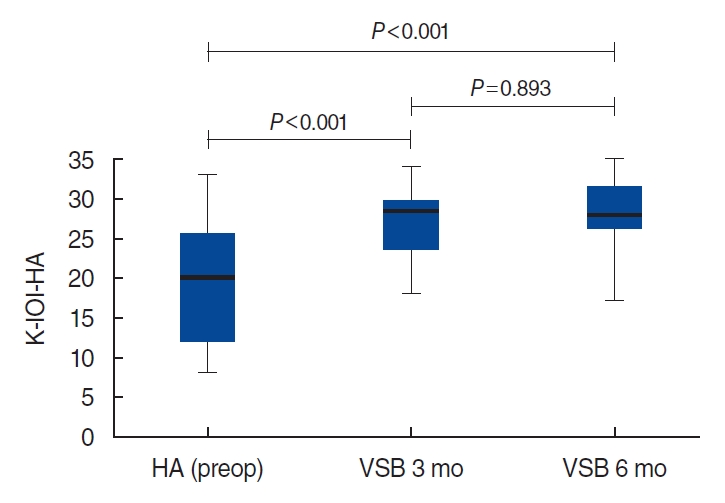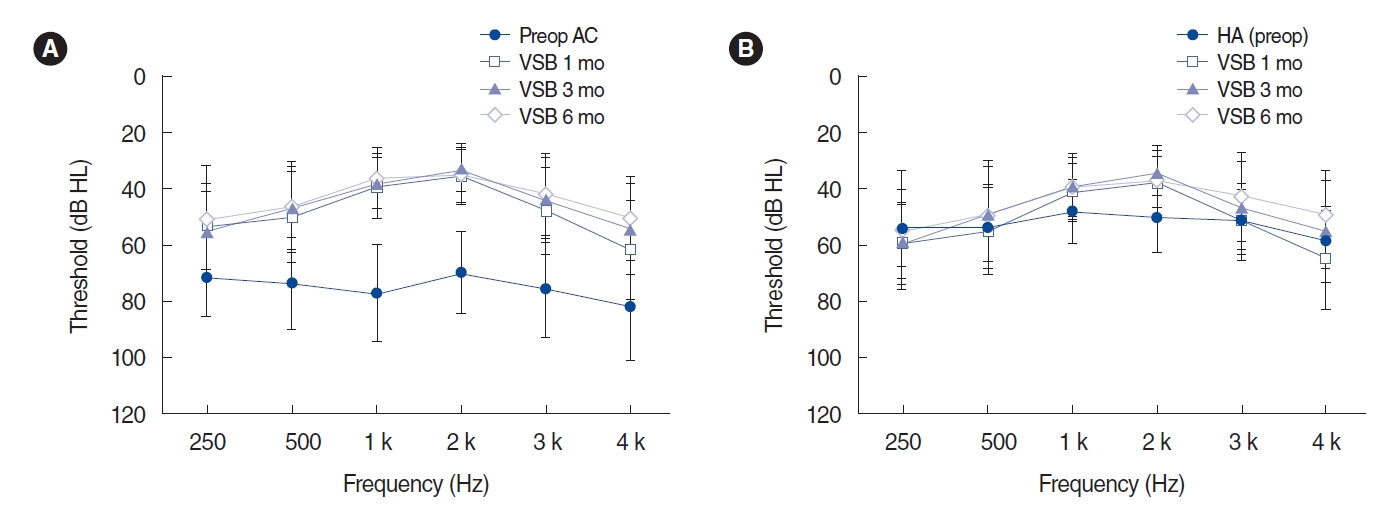Clin Exp Otorhinolaryngol.
2022 Feb;15(1):69-76. 10.21053/ceo.2020.01851.
Results of Active Middle Ear Implantation in Patients With Mixed Hearing Loss After Middle Ear Surgery: A Prospective Multicenter Study (the ROMEO Study)
- Affiliations
-
- 1Department of Otorhinolaryngology, Yonsei University College of Medicine, Seoul, Korea
- 2Department of Otolaryngology-Head and Neck Surgery, Chonnam National University Hospital, Chonnam National University Medical School, Gwangju, Korea
- 3Department of Otorhinolaryngology, Seoul National University Bundang Hospital, Seoul National University College of Medicine, Seongnam, Korea
- 4Department of Otorhinolaryngology-Head and Neck Surgery, Chungnam National University School of Medicine, Daejeon, Korea
- 5Department of Otolaryngology, Ajou University School of Medicine, Suwon, Korea
- 6Department of Otorhinolaryngology-Head and Neck Surgery, Asan Medical Center, University of Ulsan College of Medicine, Seoul, Korea
- 7Department of Otorhinolaryngology-Head and Neck Surgery, Samsung Medical Center, Sungkyunkwan University School of Medicine, Seoul, Korea
- 8Department of Otorhinolaryngology-Head and Neck Surgery, Samsung Changwon Hospital, Sungkyunkwan University School of Medicine, Changwon, Korea
- 9Department of Otorhinolaryngology-Head and Neck Surgery, Soonchunhyang University College of Medicine, Seoul, Korea
- 10Department of Otorhinolaryngology-Head and Neck Surgery, Pusan National University Yangsan Hospital, Pusan National University School of Medicine, Yangsan, Korea
- 11Department of Otorhinolaryngology-Head and Neck Surgery, Soonchunhyang University Bucheon Hospital, Soonchunhyang University College of Medicine, Bucheon, Korea
- 12Department of Otorhinolaryngology-Head and Neck Surgery, Seoul National University Hospital, Seoul National University College of Medicine, Seoul, Korea
- 13Department of Otorhinolaryngology-Head and Neck Surgery, Kyungpook National University Hospital, School of Medicine, Kyungpook National University, Daegu, Korea
- 14Department of Otorhinolaryngology-Head and Neck Surgery, College of Medicine, The Catholic University of Korea, Seoul, Korea
- KMID: 2527114
- DOI: http://doi.org/10.21053/ceo.2020.01851
Abstract
Objectives
. This study was conducted to evaluate the user satisfaction, efficacy, and safety of round window (RW) vibroplasty using the Vibrant Soundbridge (VSB) in patients with persistent mixed hearing loss after mastoidectomy.
Methods
. The study included 27 patients (mean age, 58.7 years; age range, 28–76 years; 11 men and 16 women) with mixed hearing loss after mastoidectomy from 15 tertiary referral centers in Korea. The VSB was implanted at the RW. The Korean translation of the Abbreviated Profile of Hearing Aid Benefit (APHAB) questionnaire and the Korean version of the International Outcome Inventory for Hearing Aids (K-IOI-HA) questionnaire were used to evaluate user satisfaction as the primary outcome. The secondary outcome measures were audiological test results and complication rates.
Results
. The mean scores for ease of communication (61.3% to 29.7% to 30.2%), reverberation (62.1% to 43.1% to 37.4%), and background noise (63.3% to 37.7% to 34.3%) subscales of the APHAB questionnaire significantly decreased after VSB surgery. The mean K-IOI-HA scores at 3 and 6 months after surgery were significantly higher than the mean preoperative score (18.6 to 27.2 to 28.1). The postoperative VSB-aided thresholds were significantly lower than the preoperative unaided and hearing aid (HA)-aided thresholds. There was no significant difference between preoperative unaided, preoperative HA-aided, and postoperative VSB-aided maximum phonetically balanced word-recognition scores. None of the 27 patients experienced a change in postoperative bone conduction pure tone average. One patient developed temporary facial palsy and two developed surgical wound infections.
Conclusion
. RW vibroplasty resulted in improved satisfaction and audiological test results in patients with mixed hearing loss after mastoidectomy, and the complication rate was tolerable.
Keyword
Figure
Reference
-
1. Cristobal F, Gomez-Ullate R, Cristobal I, Arcocha A, Arroyo R. Hearing results in the second stage of open mastoidectomy: a comparison of the different techniques. Otolaryngol Head Neck Surg. 2000; May. 122(5):748–51.
Article2. Galm T, Martin TP, Raut V. Open and closed cavity mastoid operations: comparing early hearing results. Eur Arch Otorhinolaryngol. 2013; Jan. 270(1):77–80.
Article3. Cox MD, Trinidade A, Russell JS, Dornhoffer JL. Long-term hearing results after ossiculoplasty. Otol Neurotol. 2017; Apr. 38(4):510–5.
Article4. Geerse S, Bost TJ, Allagul S, de Wolf MJ, Ebbens FA, van Spronsen E. Hearing and hearing rehabilitation after obliteration of troublesome mastoid cavities. Eur Arch Otorhinolaryngol. 2020; Dec. 277(12):3307–13.
Article5. Gluth MB, Friedman AB, Atcherson SR, Dornhoffer JL. Hearing aid tolerance after revision and obliteration of canal wall down mastoidectomy cavities. Otol Neurotol. 2013; Jun. 34(4):711–4.
Article6. Maw J. The Vibrant Soundbridge: a global overview. Otolaryngol Clin North Am. 2019; Apr. 52(2):285–95.7. Zahnert T, Mlynski R, Lowenheim H, Beutner D, Hagen R, Ernst A, et al. Long-term outcomes of vibroplasty coupler implantations to treat mixed/conductive hearing loss. Audiol Neurootol. 2018; Mar. 23(6):316–25.
Article8. Butler CL, Thavaneswaran P, Lee IH. Efficacy of the active middle-ear implant in patients with sensorineural hearing loss. J Laryngol Otol. 2013; Jul. 127 Suppl 2:S8–16.
Article9. Lee JM, Jung J, Moon IS, Kim SH, Choi JY. Benefits of active middle ear implants in mixed hearing loss: stapes versus round window. Laryngoscope. 2017; Jun. 127(6):1435–41.
Article10. Ernst A, Todt I, Wagner J. Safety and effectiveness of the Vibrant Soundbridge in treating conductive and mixed hearing loss: a systematic review. Laryngoscope. 2016; Jun. 126(6):1451–7.
Article11. Chu H, Cho YS, Park SN, Byun JY, Shin JE, Han GC, et al. Standardization for a Korean adaptation of the international outcome inventory for hearing aids: study of validity and reliability. Korean J Otorhinolaryngol-Head Neck Surg. 2012; Jan. 55(1):20–5.
Article12. Lim HJ, Park MK, Cho YS, Han GC, Choi JW, An YH, et al. Validation of the Korean version of the abbreviated profile of hearing aid benefit. Korean J Otorhinolaryngol-Head Neck Surg. 2017; Apr. 60(4):164–73.
Article13. Kumakawa K, Kanzaki S, Usami S, Iwasaki S, Yamanaka N, Doi K, et al. Multicenter clinical study of Vibrant Soundbridge in Japan: analysis of subjective questionnaires. Nihon Jibiinkoka Gakkai Kaiho. 2015; Nov. 118(11):1309–18.14. Dornhoffer JR, Meyer TA, Dubno JR, McRackan TR. Assessment of hearing aid benefit using patient-reported outcomes and audiologic measures. Audiol Neurootol. 2020; Jul. 25(4):215–23.
Article15. Atas A, Tutar H, Gunduz B, Bayazıt YA. Vibrant SoundBridge application to middle ear windows versus conventional hearing aids: a comparative study based on international outcome inventory for hearing aids. Eur Arch Otorhinolaryngol. 2014; Jan. 271(1):35–40.
Article16. Iwasaki S, Usami SI, Takahashi H, Kanda Y, Tono T, Doi K, et al. Round Window application of an active middle ear implant: a comparison with hearing aid usage in Japan. Otol Neurotol. 2017; Jul. 38(6):e145–51.
Article17. Brkic FF, Riss D, Auinger A, Zoerner B, Arnoldner C, Baumgartner WD, et al. Long-term outcome of hearing rehabilitation with an active middle ear implant. Laryngoscope. 2019; Feb. 129(2):477–81.
Article18. Schwab B, Salcher RB, Maier H, Kontorinis G. Oval window membrane vibroplasty for direct acoustic cochlear stimulation: treating severe mixed hearing loss in challenging middle ears. Otol Neurotol. 2012; Jul. 33(5):804–9.19. Bernardeschi D, Hoffman C, Benchaa T, Labassi S, Beliaeff M, Sterkers O, et al. Functional results of Vibrant Soundbridge middle ear implants in conductive and mixed hearing losses. Audiol Neurootol. 2011; Sep. 16(6):381–7.
Article20. Truy E, Philibert B, Vesson JF, Labassi S, Collet L. Vibrant Soundbridge versus conventional hearing aid in sensorineural high-frequency hearing loss: a prospective study. Otol Neurotol. 2008; Aug. 29(5):684–7.21. Labassi S, Beliaeff M, Pean V, Van de Heyning P. The Vibrant Soundbridge® middle ear implant: a historical overview. Cochlear Implants Int. 2017; Nov. 18(6):314–23.22. Khan A, Hillman T, Chen D. Vibrant Soundbridge rehabilitation of sensorineural hearing loss. Otolaryngol Clin North Am. 2014; Dec. 47(6):927–39.
Article23. Zwartenkot JW, Mulder JJ, Snik AF, Cremers CW, Mylanus EA. Active middle ear implantation: long-term medical and technical follow-up, implant survival, and complications. Otol Neurotol. 2016; Jun. 37(5):513–9.24. Barbara M, Volpini L, Covelli E, Romeo M, Filippi C, Monini S. Complications after round window vibroplasty. Eur Arch Otorhinolaryngol. 2019; Jun. 276(6):1601–5.
Article25. Schmuziger N, Schimmann F, aWengen D, Patscheke J, Probst R. Long-term assessment after implantation of the Vibrant Soundbridge device. Otol Neurotol. 2006; Feb. 27(2):183–8.
Article





